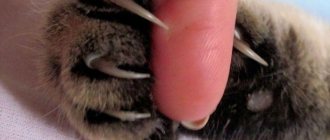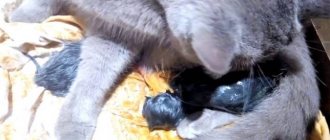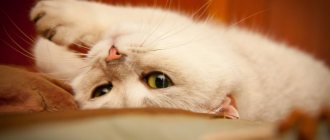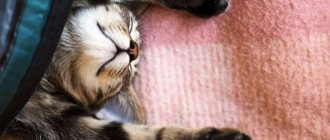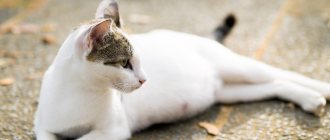9797Administration
Oxytocin is a hormonal drug that affects uterine contraction, myoepithelial cells and mammary ducts. In a cat's body, this is a hormone from the posterior lobe of the pituitary gland, which is produced during contractions and when the nipples are irritated. Oxytocin is used during childbirth in cats to quickly expel the kitten's fetus and further reduce it.
The composition of Oxytocin acts quickly: the substance dissolves in the blood in no more than 6 minutes, and the body’s first reaction is observed within 3-4 minutes.
© shutterstock
Correct Application
The place for administering the hormone to the animal is the withers.
In order not to provoke an overdose, Oxytocin should be injected after consultation with a veterinarian. The doctor will select the required dose for each specific cat depending on its body weight. You will need to resort to medication between contractions when they have subsided. With this, it will be possible to achieve stimulation of the smooth muscles of the uterus. It is recommended to administer about 0.3 ml of medication at a time. The cocktail is placed at the withers. If the contractions slow down, the cat owner will need to carefully remove the kitten themselves, using sterile gloves.
Sometimes you need to arm yourself with Vaseline.
Lynxin miniature
A cat's gestation period is 58-72 days.
If the cat’s labor is good, then there is no need to use medications before and during birth. After birth, two hours after the last kitten, oxytocin can be administered to better cleanse the uterus and increase milk lactation.
The use of medications during childbirth in a cat
For experienced breeders this advice is unnecessary, but for beginners I would like to remind you that you are not a veterinarian. Therefore, use medications very carefully and do not try to pour and inject everything into the cat. Improper use of medications can seriously harm your cat.
Trauma to a cat during childbirth
Travmatin® acts on the neuroendocrine system, stimulates the production of endogenous (own) oxytocin, which leads to uterine contractions. In addition, Travmatin® has an analgesic and hemostatic effect. Even during normal childbirth without obstetric care, there is a risk of microtrauma to the mucous membrane of the cervix and vagina. Therefore, Travmatin® should be administered both at the beginning of labor and at the end of the process. This allows you to avoid complications both during childbirth and in the postpartum period, prevents inflammatory diseases of the genital organs and promotes normal involution of the uterus (when the uterus returns to its original state). The composition of Travmatin® in microdoses includes natural components created on the basis of plant raw materials, so it is absolutely harmless to the fetus and the mother in labor. The dosage of the drug for cats is 1 ml. Travmatin® is injected subcutaneously into the withers area or intramuscularly. In addition, the drug can be given orally in 5-15 drops (if it is impossible to give an injection, a very small or nervous animal), if necessary (weakening of labor in case of large fetuses or large litter size), frequent administration is possible (every 15-20 minutes). If the postpartum period is accompanied by severe bleeding from the genitals, the animal must be given an injection of Travmatin® and consult a doctor immediately! Don’t panic, stay calm, keep Travmatin® on hand, and your animal will give birth naturally and easily.
Gamavit for a cat during childbirth
Subcutaneously, 2 ml before labor or during labor as needed. Gamavit is used to normalize labor in complicated cases. The drug stimulates the smooth muscles of the uterus, accelerating and facilitating the birth process, and promotes rapid cleansing of the uterine horns from dead fetuses. For weakened kittens, 0.01 ml subcutaneously.
Oxytocin for a cat during childbirth
Oxytocin has the ability to enhance contractions of the smooth muscles of the uterus and myoepithelium of the mammary gland. Attention! Oxytocin can be released in different forms. Oxytocin 5 units and oxytocin 10 units. Recalculate the dosage in accordance with the purchased drug! This drug is injected during weak labor. It causes contractions of the uterus. In most cases, oxytocin is not recommended until the first kitten is born. It is also strictly contraindicated in the case when the kitten is stuck in the birth canal. Oxytocin is injected into the withers in a volume of 0.2-0.3 ml. One time. NOT INTO A FIGHT! If after 20 minutes there is no reaction, then inject again. In case of weak labor, they usually inject according to this scheme - 02. ml 3 times with a break of 20 minutes. You can inject intramuscularly, then the reaction will follow faster. !!! Oxytocin is contraindicated during obstetrics in cases of a large fetus, its deformity, as well as in case of incorrect position and position. Cocktail that stimulates labor in cats
If you are afraid to administer oxytocin, administer a 10 ml subcutaneous cocktail. No risk at all, just pure benefit. Tested in prolonged labor. The action of the cocktail is fundamentally different from the mechanism of action of oxytocin and similar drugs (oxytocin “works” at the level of nerve fibers, “forcing” the muscles of the uterus to contract, and the cocktail stimulates the contraction of the smallest blood vessels without affecting the nerves... therefore “uterine fatigue” does not comes... Moreover, if it is necessary to use oxytocin, “before” it is recommended to inject such a cocktail... In addition, the cocktail DOES NOT ALLOW uterine ruptures and bleeding, and the largest kittens are born remarkably and without problems only with its use (without the participation of oxytocin)... Inject you can UNTIL INFINITY - as much as needed = uterine fatigue DOES NOT OCCUR.The difference between subcutaneous, intramuscular and intravenous administration is the speed of action... Roughly speaking = subcutaneously the result occurs after 10 minutes, intramuscularly - after 5 minutes, intravenously - instantly. After the birth of PRESUMABLY the last kitten - I always inject oxytocin. Cocktail - I inject for another 3 days, after birth (1 injection per day, in the same dosage as during childbirth) ... and again - reinsurance, for possible eclampsia... NOW THE RECIPE ITSELF:
- 4 ml (cube) glucose
– 4 ml (cube) calcium gluconate
— 2 ml (cubes) of ascorbic acid All components are taken into one syringe, total volume = 10 ml (cubes). Inject at the rate of 2 cubes per 10 kg of cat’s weight. Single dose for a medium-sized cat = 1 ml. Injection after the birth of the first kitten!!! Maintains the tone of the uterus and stimulates the release of clots, replenishes fluid loss and feeds, “washes out” the placenta, stimulates milk production. Very good during long labor. Cocktail to restore strength and energy
calcium gluconate 10% -2 ml
- ascorbic acid – 1 ml
- glucose 5% - 7-10 ml
For two subcutaneous injections of 10 ml every hour. The cat's weight is from 3.5 to 5 kg. Do you understand? not for stimulation, not for vitaminization, and not for prevention - To replenish what was lost!!! This cocktail is used ONLY DURING childbirth (after 3-4 kittens) or AFTER BIRTH. To replenish lost: strength and energy (nutrition and fluids - glucose, stress relief and removal of toxins - vitamin C, calcium.) Calcium gluconate during cat birth
Calcium gluconate or calcium borgluconate (1 ml intramuscularly) Calcium gluconate is injected only INTRAMUSCULARLY (!!!), warmed up to body temperature (the required amount is drawn into a syringe and held in the hand until it warms up). The drug gently enhances contractions and labor, and also promotes milk production. During childbirth, calcium is injected when regular contractions begin (see the cat's condition, if necessary). 1 ml at a time, bring to 4 ml. After childbirth, a prophylactic dose of 1 ml once a week. If the cat shows the first signs of eclampsia, give it 1 ml in the morning and 1 ml in the evening for three days. To relieve an attack of eclampsia, inject 2 ml, repeat after 30 minutes until the attack is completely relieved. The maximum total dose is 10 ml. You can drink calcium gluconate, but it’s useless! In addition, it is advisable to give the cat a sedative; with the sedative, the signs of the disease go away much faster. The veterinary drug calcium borgluconate is injected INSTEAD of calcium gluconate according to the same scheme, subcutaneously or intramuscularly. Don't solder!!! Traumeel (traumatin) one drop in the mouth of a weakened kitten every 15 minutes for two hours. For cats, 0.5–2 ml subcutaneously or intramuscularly to relieve pain.
Helping a cat during labor
If the kitten gets stuck on the way out.
During the normal course of childbirth, you should not interfere with this natural process; you can simply help the female. If the cat has pinched the kitten out of pain and fear, for example, in the neck area (i.e. body out, head in), then by gently pulling you can try to speed up the birth. This is especially important in breech presentation, when compression of the umbilical cord is possible. At the same time, oxygen ceases to enter the fetal body, as a result of which a reflex inhalation follows and amniotic fluid enters the lungs. With a cephalic presentation, the membranes are open, air can pass into the lungs during breathing movements. It is better to pull the fetus by the folds of skin on the neck or torso, always during pushing, carefully, but quite strongly, as if in an arc - outward and downward. If the birth canal is dry, it needs to be moistened. Bubble sticking out
If it is the bubble that is sticking out, then you don’t need to do anything, just don’t let the cat bite through it. You can begin mechanical stimulation of contractions. The cat does not chew the umbilical cord
The kitten is “hanging” on the umbilical cord. We free the kitten's nose from the amniotic sac. Grasp the umbilical cord with your thumb and forefinger as close to the cat's vulva as possible. During the contraction we stretch. If there are no contractions, but the cat jumps up and spins around, sits down (risk of crushing the kitten), cut it off. Ideally, of course, use a medical clamp. The umbilical cord was clamped. Cut off from the kitten's side. The remainder of the umbilical cord is secured with a clamp from the outside and will not go back into the cat. We bring the kitten back to life. Then we put it to the mother, she is distracted by it (licks it), and you take the clamp in your hands and remove the afterbirth. The afterbirth does not come out
If the placenta hanging from the genital slit does not separate within half an hour or interferes with the birth of the next fetus, it is carefully removed by hand. Mechanical stimulation of contractions
We fix the cat in the “pooping” position. Gently massage the abdomen using circular movements. We put on gloves, dip a finger in Vaseline oil, insert it into the vagina 1 cm and make circular movements. If a bubble sticks out, then massage it around until contractions appear.
When is it prohibited to use?
Oxytocin should not be given to cats that have smooth muscle scarring. This precaution is due to the fact that the use of the medication can cause traumatic injuries. Pharmaceuticals are not used in situations where the fetus is lying incorrectly. Intensifying contractions can cause serious injuries to the baby. Oxytocin should not be used if the cat has been diagnosed with bronchospasm or tachycardia. It is prohibited to use the medication if your pet is individually intolerant to certain components contained in the composition. A high risk of eclampsia is also considered a contraindication.
Why is Oxytocin used?
The hormonal drug is used in weak labor, when the cat’s contractions disappear. Most often these are old animals over eight years old. Oxytocin causes contractions of the uterus, and helps it quickly release the fetus. The hormone is also effective after childbirth. It stimulates rapid cleansing of the uterus and the secretion of breast milk.
Oxytocin is administered during labor, between contractions. And preferably after the birth of the first kitten to avoid uterine rupture. A small amount of the drug can also be injected after childbirth.
Adverse reactions
The drug can lead to an allergic reaction in your pet.
Sometimes “Oxytocin” provokes allergies in cats, which in its manifestations is similar to anaphylactic shock. A slight redness in the area of the injection is considered a normal physiological reaction of the pet’s body and should not alert its owner. It is important for the owner to take into account that the medication interacts with other medications. Therefore, if several pharmaceutical products are used at once, it is important to consult a veterinarian. In the opposite situation, “Oxytocin” can interact, resulting in the formation of chemicals that can cause poisoning in the cat’s body.
special instructions
While using the medication, the cat owner is prohibited from eating, smoking and drinking. After the first injection and each subsequent time, it is important to wash your hands thoroughly with soap. The container containing the medicine must be disposed of immediately and not used for household purposes. If the medication gets on the mucous membranes or skin, you need to rinse them as soon as possible with plenty of water. When allergy symptoms appear, you should not hesitate to visit a medical facility.
Analogues of the drug
If the doctor deems it necessary, he can prescribe a similar drug to the animal - Oxytocin-Richter.
Pharmacy chains also offer other medications that are given to cats during childbirth. The doctor may prescribe the following pharmaceuticals:
- "Desaminooxytocin";
- "Oxytocin grindex";
- "Oxytocin-biolek";
- "Oxytocin Richter."
It is important to remember that it is strictly prohibited to independently replace a prescribed medication. All medications have their own side effects and contraindications for use, which are important to consider before using them. Only a veterinarian who is familiar with the cat’s medical history and the individual characteristics of its body has the right to replace the medicine.
General information about the drug
Oxytocin is a pituitary hormone that causes strong, coordinated contractions of the uterus during labor. The same substance is abundantly synthesized by the body in large quantities during lactation. Note that the most typical scenario for its veterinary use is the elimination of uterine dystonia. This is a pathology characterized by weak or absent contractions of the organ during childbirth.
Historically, up to 2.5 IU of the drug was recommended per cat. But recent studies have proven that such doses contribute to excessively strong intrauterine contractions, which, in some cases, can even lead to damage to internal organs, and therefore do not contribute to normal childbirth.
Scientists also found that even half the doses still do not stimulate the uterine muscle receptors beyond what is possible. To put it simply, there is no point in using oxytocin in cases where its single administration did not help the cat give birth. Nothing good will come of this anyway.
It is strictly forbidden to use the drug during difficult childbirth without first making sure that the animal’s birth canal is not “blocked” by a stuck kitten, tumor, dead fetus or other foreign bodies.
The standard dose for cats recommended by veterinarians today is 0.25 to 0.5 IU. It is not necessary to administer this amount of hormone at one time: the dose can be divided into two or three doses with an interval of 20-30 minutes between them. However, there is no particular point in administering more than 0.25 IU - this is the standard dose for animals whose weight does not exceed five kilograms.
Only in cases where the initial administration did not produce any pronounced effect is it possible to increase the volume of the drug by 0.5 IU once. If even after this full-fledged uterine contractions are not detected, it is highly recommended to immediately perform a cesarean section.
